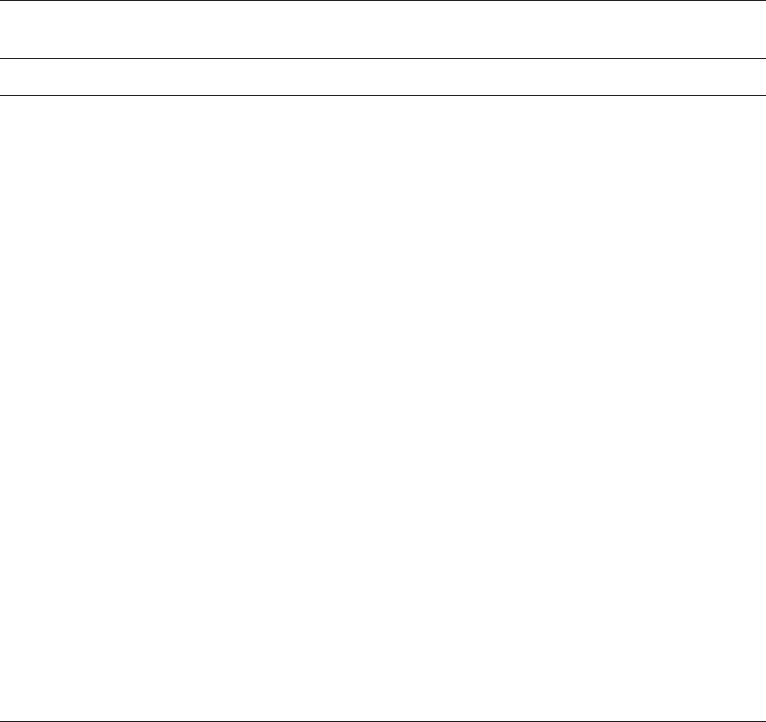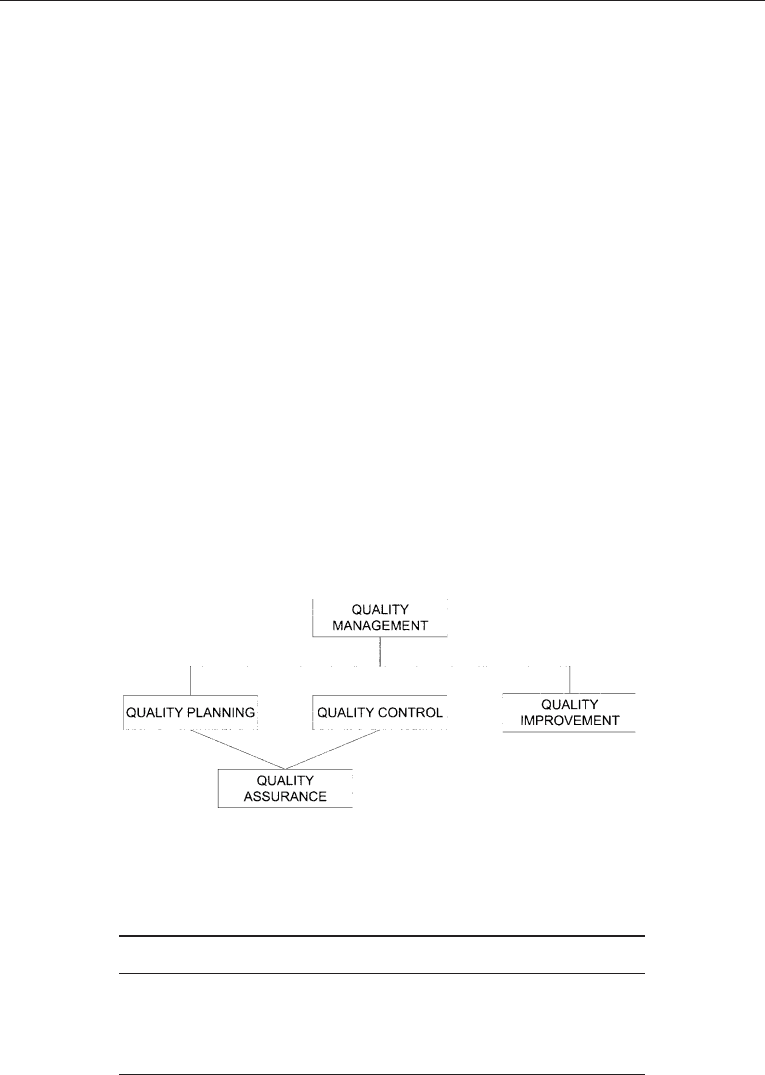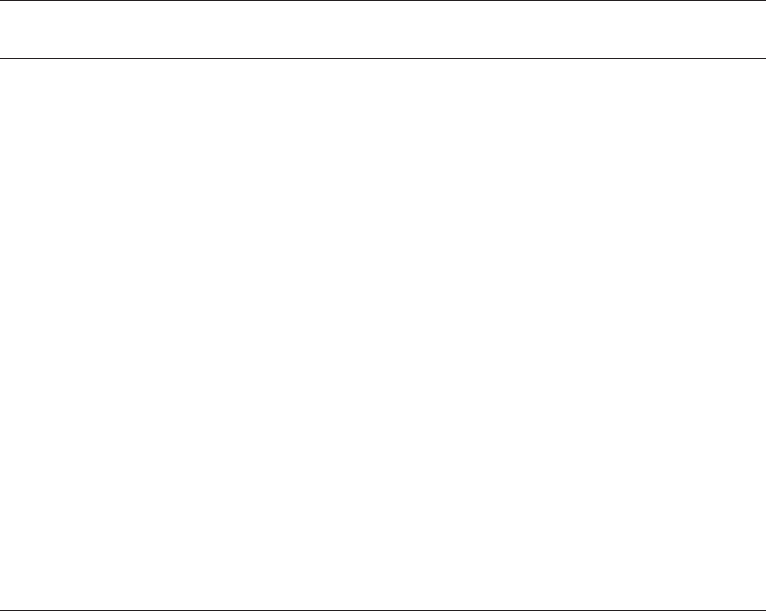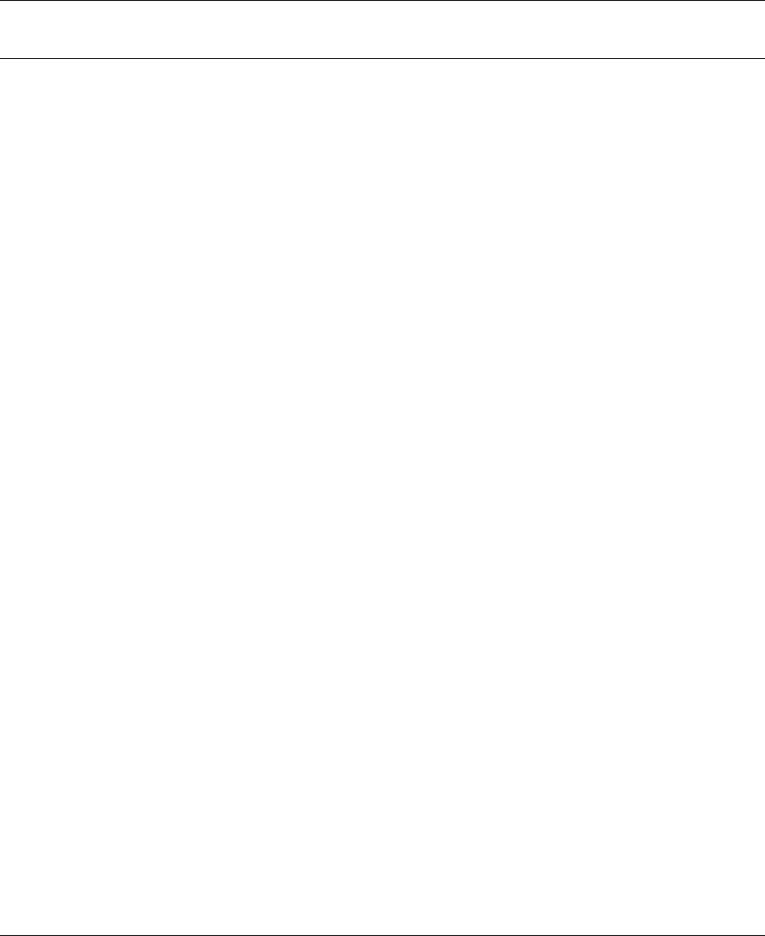Kristiansen Svein. Maritime Transportation: Safety Management and Risk Analysis
Подождите немного. Документ загружается.


greater detail later in the chapter. True safety orientation is also visible through the
priorities set by top management. Fundamentally it is a matter of how safety is balanced
against time and money in daily operations.
1 5 .1.3 The Mar i ti m e Safety M anagemen t Regim e
The rules and regulations governing safety and environmental protection within the
shipping industry have evolved over time through what may be described as a set of
interrelated stages. The earliest and most basic stage focused primarily on the con-
sequences of accidents resulting from failures made in relation to safety. In the co ntext
of this safety regime, major efforts were made in the aftermath of accidents to find
someone to blame for personal injuries, fatalities, damage to or loss of ship and cargo, and
environmental pollution. This created a culture of punishment, where the essential theme
was to identify and allocate/apportion blame. Frequently the last people in the chain of
Ta b l e 1 5 . 2 . Safety orientation dimensions
Safety orientation dimensions Explanation
Safety view Safety incorporated as an essential part of the
business policy
Proactive attitude
Public responsibility
Long-term perspective
Set priorities Documented and visible policy
Give safety priority and allocate the necessary resources
Culture Credible leadership: ‘Do as you say’
True concern for safety at all levels of the organization
Establish a set of ‘symbols/heroes/rituals/values’
Human values Genuine concern for crew, staff and middle management
Emphasis on worker safety and health
Personnel policies that support motivation and
responsibility
Operate systematically Implement safety plan, programmes and routines
Establish a safety management system
TQM approach: Plan/do/check/review cycle
Protect against potential hazards Formal Safety Assessment (FSA), Safety Case approach
Risk-based engineering
Emergency preparedness
Proceed cautiously Limit the pace of technical innovations in each project
Design verification
Test the risks
Learn from experience Openness to risks and safety problems
Inspections, maintenance
Auditing of the safety management system
466 CH APTER 15 SA FETY MANAG EMENT

events, i.e. the peo ple at the sharp end of the system, were found responsible. The
underlying principle of this safety management regime was that the threat of punishment
should influence companies and individual behaviour to the extent that safety gained a
higher priority. Although the maritime safety management regime has principally evolved
away from this early stage of development, the culture of punishment is still to be found in
the aftermath of accidents as well as in many maritime regulations. For example, the US
Oil Pollution Act (OPA 90) gives shipowners full economic liability for oil spills in US
coastal waters.
What may be described as the second stage of development regarding the maritime
safety management regime involves the regulation of safety by prescription, i.e. the
prescriptive regime in which the maritime industry is given sets of rules and regulations to
be obeyed. For example, the provisions of ILLC 1966 (the International Convention on
Load Lines), SOLAS 1974 (the International Convention for Safety of Life at Sea),
MARPOL 73/78 (the International Convention for the Prevention of Pollution from
Ships), COLREG 1972 (the Convention on the Internationa l Regulations for Preventing
Collisions at Sea) and STCW 78/95 (the Standards for Training, Certification and
Watchkeeping for Seafarers) provide the basis for the prescriptive (or external) regulatory
framework for international shipping. The prescribing party is normally a country
government or its legislative bodies, or an international organization in which a number of
countries participate (e.g. the IMO). The prescr ibed rules and regula tions have normally
been based on past experiences and very rarely have proactive rules been included. The
prescriptive regime affects and is employed in all parts of a vessel’s life-cycle, i.e. design,
construction, operation, modification/refurbishment, and decommissioning.
The second stage of development is an advance on the first stage (the culture of
punishment) because it is designed to attack known points of danger before actual harm
occurs. This leads to a culture of compliance with prescriptive rules. However, more
recently there has been a growing belief that the application of prescriptive rules is not
enough: rules and regulations provide the means to achieve safety, but this should not be
an end in itself.
The third and most advanced stage in the evolution of t he maritime safety
management regime is the creation of a so-called culture of self-regulation of safety,
where regulation goes beyond the setting of externally imposed compliance criteria as
in the second stage. The culture of self-regulation concentrates on internal management
and organization for safety, and encourages individual industries and companies to
establish targets for safety performance. Self-regulation also emphasizes the need for every
company and individual to be responsible for the actions taken to improve safety, rather
than seeing them imposed from external prescriptive parties. This requires the develop-
ment of company-specific and, in the case of shipping, vessel-specific safety management
systems (SMS ). It can be concluded that in the culture of self-regulation, safety is
organized by those who are directly affected by the implications of failure.
As mentioned earlier, the regulation of safety in the shipping industry has, historically,
been characterized by a culture of punishment and a culture of external compliance.
IMO’s adoption of the International Safety Management (ISM) Code, which is made
mandatory in all member states, is an important step towards the creation of a culture of
15.1 INTRODUC T ION 467

self-regulation in shipping. The increasing focus on safety management represents an
important transition from the traditional principle of prescriptive regulations that
dominate the maritime sector. Self-regulation is not, however, completely effective on its
own. In order to achieve safer seas and environmental pro tection it is necessary for all
three regimes/stages described above to coexist. Each regime plays a significant part in
influencing company and individual behaviour. The ISM code will be reviewed in detai l
later in this chapter.
With regard to improving maritime safety, the following factors and aspects have been,
and still are, in focus:
. Technical solutions
. Training and competence (i.e. human factors)
. Workplace conditions (i.e. ergonomics)
. Management and organization
. Risk-based planning and design
The causal factors resulting in ship accidents reveal that there is considerable potential
for improvement with regard to human and organizational factors (HOF), at least relative
to what can be gained today through the implementation of improved technical solutions
in North European and North American flag states. In the emerging Total Quality
Management (TQM) thinking there is an increasing tendency to see health, safety and
environment (HSE) as elements in an integrated management approach.
15. 2 TOTAL QUALIT Y MANAGEMENT ( TQM )
15.2.1 Basic Theory
As pointed out earlier, safety has traditionally been seen in a regulatory perspective. This
means that the shipowner or manager operates within the framework of prescriptive safety
regulations. This view is now changing rapidly because of the so-called quality thinking
that is gaining increasing acceptance and thereby blending the different aspects of quality
management together. Increasingly, safety management will therefore be seen as an
integral part of the overall management system of a company. Safety is only one of a
number of factors that express the quality of a business, which may involve the following
factors:
. Long-term perspective
. Customer orientation
. Leadership involvement
. Continuous improvement
. Fact-based management
. Employee involvement at all levels
. Good relations with subcontractors
. Corporate responsibility
. Good and effective health, safety, and environmental policies
468 CH APTER 15 SA FETY MANAG EMENT

Quality affects every aspect of business. A popular and emerging management
philosophy that bases itself on this all-embracing notion of quality is the so-called Total
Quality Management or TQM (Costin, 19 98). Juran (1998) has stated the following
motivations for the TQM approach:
. There is a crisis in quality.
. Our traditional ways of dealing with quality crises are inadequate.
. Quality management affects all functions and every level (of the hierarchy) of the
organization, and hence requires a universal way of thinking.
. There is a need for continuous learning and improvement at all organizationa l levels.
The so-called ‘Juran Trilogy’, as illustrated by Figure 15.1, focuses on quality planning,
control and improvement, as well as quality assurance. This quality model is the
underlying basis of the TQM philosophy. In order to clarify the concepts in Figure 15.1,
the quality of the financial function of an organization can be studied as shown in
Table 15.3.
Three important characteristics and key conditions of successful quality manage-
ment are a clear policy regarding quality, continuous improvement, and comprehensive
management commitment. In addition to presenting the quality model (i.e. Figure 15.1),
Juran (1998) also outlines the processes underlying each of the three basic quality
functions in this model, i.e. quality planning, quality control and quality improvement.
These processes are presented in Table 15.4.
Ta b l e 1 5 . 3 . The financial function of an organization seen in the context
of the quality model
Financial Quality
Budgeting Quality planning
Cost/expense control Quality control
Cost reduction, profit improvement Quality improvement
Audit Quality assurance
Figure 15.1. The quality model.
15.2 T O TAL QU ALITY MANA GEMENT (T QM) 469

15.2.2 Safety Management Based on TQM
Central to the TQM philosophy is the so-called ‘plan/do/check/ review’ loop, in which
quality is improved on a continuous basis. As pointed out earlier, safety is a quality of
an organization. The organizational safety level can be managed through the use of a
set of basic safety management activities. These activities may be modelled in a ‘safety
management spiral’ as illustrated in Figure 15.2. The spira l form is used to indicate
that safety management within an organization should be an iterative process, which
is in accor dance with the important TQM prin ciple of continuous improvement
(Aitken et al., 1996).
The five basic components in the safety management system (SMS) in Figure 15.2,
which is heavily influenced by TQM , are as follows:
. Policy: All organizations have a set of policies that are used to guide the performance
of the staff so that the overall objective of the organization can be achieved in an
effective way. Safety goals (i.e. the level of safety one wishes to achieve) should be
included as a vital part of the policies. Policies have a tendency to be quite static
documents, but to achieve a well-functioning safety management system one must
Ta b l e 1 5 . 4 . The processes underlying quality planning, quality control and quality improvement
Quality planning Identify customers, both external and internal
Determine customer needs
Develop product features (both goods and services) that respond
to customer needs
Establish quality goals that meet the needs of customers and
suppliers alike, and do so at a minimum combined cost
Develop a process that can produce the needed product features
Prove process capability – prove that the process can meet
the quality goals under operating conditions
Quality control Choose control subjects, i.e. what to control
Choose units of measurement
Establish measurement
Establish standards of performance
Measure actual performance
Interpret the difference between actual and standard performance
Take action on the difference
Quality improvement Prove the need for improvement
Identify specific projects for improvement
Organize to guide the projects
Organize for diagnosis, i.e. for discovery of causes
Diagnose to find causes
Provide remedies
Prove that the remedies are effective under operating conditions
Provide for control to maintain gains
470 CHAPTER 15 SAFETY MANAGEM ENT

establish a culture where policies are developed and improved over time as a result of
the iterating safety management process.
. Organizat ion: It is of great importance that the management system establishes the
responsibilities of individuals with regard to safety matters. This has to be done with
an understanding of the needs of communication and co-operation between the
individuals involved, and the need for proper education and competence within the
organization.
. Implementation: The implementation phase should make sure that the policies and
objectives are translated into practice. The results of this implementation are ‘tested’
through the application of the SMS.
. Measurement: The objective of the measurement task is to measure whether the
implementation went as intended and its effectiveness. The information from this stage
is fed into the review phase/stage of the SM S.
. Review: It is necessary to have a mechanism for reviewing the performance of a
system and to seek ways to continuous ly improve it. The review phase/stage uses the
information obtained by measurement to review/audit and analyse the performance of
the system. Auditing is the only non-destructive way in which lessons can be learned
and fed into the system for enhancement. The review phase should examine the total
range of safety management activities, i.e. policies, orga nization, implementation and
measurement.
Clement et al. (1996) have outlined how principles from TQM can be applied in the
development of an integrated healt h, safety and environm ent (HSE) management system
suitable for implementation into all business processes. The process of introducing TQM
involves a number of steps, which can be illustrated by Figure 15.3. As can be seen from
Figure 15.2. Safety management modelled as a spiral illustrating safety management as an activity of
continuous improvement.
15.2 T O TAL QU ALITY MANA GEMENT (T QM) 471

this figure, the basic elements of this approach are consistent with the TQM-based safety
management system described above.
The integrated HSE management system that was set up put emphasis on the
wide range of elements shown in Table 15.5. The HSE policy in this table may seem
vague. The intention of incorporating and stating the company’s policies in its vision,
mission and value statements is to give the company/organization a committing and
visible direction/goal for its HSE efforts. For a particular company the policies will
normally be described more explicitly and may, for example, include the following
(Clement et al., 1996):
. Comply with all HSE laws, regulations and industry standards, and self-regulate where
there are no such prescriptive requirements.
. Exhibit socially conscious leadership and demonstrate excellent HSE performance.
. Seek to participate in developing HSE legislation, regulations and standards.
. Integrate HSE protection into every aspect of the business activities.
. Design and operate the company’s facilities followin g industry standar ds. Prevent
discharge of hazardous substances.
. Satisfactorily train employees and contractors, emphasizing individual responsibility
for sound HSE performance.
. Conserve natural resources by prudent management of emissions and discharges, and
by eliminating waste.
Figure 15.3. The process of introducingTQM. (Source: Clement et al.,1996.)
472 CHAPTER 15 SA FETY MANAGEM ENT

. Encourage employees to communicate within the company, as well as with the public,
regarding HSE matters.
. Work to resolve any pro blems created by past operations and practices.
. Ensure conformity with these policies through a comprehensive compliance
programme including audits.
Tabl e 15.5. HSE management system
Leadership and
commitment
Top management shall provide strong, visible leadership
and be fully involved
HSE shall be on the agenda in all management meetings
HSE is to be seen as a key business strategy
Accountability is of great importance
Policy HSE aspects shall be reflected or incorporated in the
company’s vision, mission and value statements
Organization The organization shall evolve from being functional to
becoming a team-based organization focused on asset
value optimization
HSE engineers/specialists shall be assigned to teams
The training programme shall be improved and
strengthened
Emergency response programmes shall be developed
Records shall be kept for documentation of plans,
management system, procedures, etc.
Implementation and
monitoring
Awareness and communications are key condition to success
Planned inspections and preventive maintenance
shall be carried out
Accidents, incidents and near-misses shall be investigated
Work rules and permits are to be used
Personal protective equipment shall be provided and used
Health hazard identification and evaluation shall be carried
out at regular intervals
Good change management is important
Environmental issues shall be identified and action plans
produced regularly
Establishing and maintaining good relations with external
stakeholders is of great priority
Measurement and
performance
The implementation shall be measured and the performance assessed
This process shall result in specific targets for the individual
business units
Audits and reviews It shall be assessed whether the HSE management system is
implemented effectively and according to the plan
Are the policy’s principles being fulfilled?
Are the objectives and performance measures achieved?
Are we in compliance with rules and regulations?
Establish areas for improvement
15.2 T O TAL QU ALITY MANA GEMENT (T QM) 473

Measurement and performance must be seen in relation to the activities of the diff erent
business units . The following list indicates typical performance measures for oil explora-
tion and production activities:
. Number of oil spill incidents
. Total volume of oil spilled
. Number of km of ro ad transport replaced with pipeline
. Area re-greened
. Km pipeline upgraded to present standard
. Volume of oily water and waste wat er discharged
. Hydrocarbon emission to air
. NO
x
and SO
x
emissions
The final element of the HSE management plan is auditing, which may be undertaken
both internally on a corporate scale, by the different business units, or by an independent
external auditor. With regard to which HSE-relevant elements of an organization
should be audited/reviewed, Clement et al. (1996) refer to a scheme developed by the
International Loss Control Institute (ILCI, 1995). According to this scheme the audit
elements are as follows:
1. Leadership and administration
2. Leadership training
3. Planned inspections and maintenance
4. Critical task analysis and procedures
5. Accident/incident/near-miss investigation
6. Task observation
7. Emergency preparedness
8. Intern al rules and work permits
9. Accident/incident/near-miss analysis
10. Knowledge and skill training
11. Personal protective equipment
12. Health and hygiene control
13. Programme evaluation
14. Engineering and change management
15. Personal communications
16. Group communications
17. General promotion
18. Hiring and placement
19. Materials and contractor management
20. Off-the-job HSE awareness
21. Environmental issue identification
22. Environmental action plan
23. Environmental performance monitoring and assessment
474 CHAPTER 15 SAFETY MANAG EMENT

24. Relations with external parties
25. Product stewardship
26. Agency permits, compliance reports and inspections
27. Off-site waste management
1 5.2.3 Quality Plan Structure
The quality plan, referring to the quality planning element of the ‘Juran Triology’ in
Figure 15.1, is the underlying basis for all quality and safety management. The key
elements of a quality plan are depicted in Figure 15.4. The starting points are the quality
policy and the requirements placed upon the organization. The plan itself consists of
careful descriptions of organizational, functional and procedural plan elements. Examples
of such quality plan elements are given in Table 15.6.
15.2.4 Quality Programme Structure
It is well known from experience that most organizations are able to define a qualit y plan
and establish the desirable standards that they want to achieve, but have greater difficulty
in living up to these standards as a part of the daily routine. In order to succeed in
improving quality (e.g. safety), a company needs not only a plan that defines the relevant
activities and quality objectives but also certain measur es that will transform the
organization into one that lives by its new policies and standards. This requires a more
rigorous approach in terms of a quality programme. The quality programme structure for
safety outlined in Figure 15.5 is more process-oriented than the quality plan previously
Figure 15.4. The quality plan.
15.2 T O TAL QU ALITY MANA GEMENT (T QM) 475
